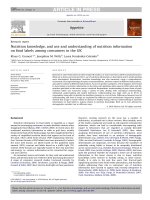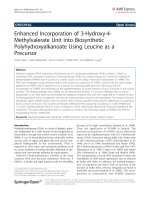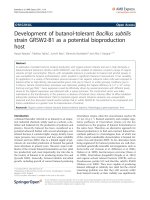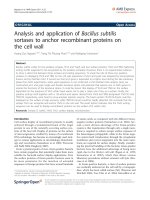flajolet p , et al mellin transforms and asymptotics harmonic sums (corrigenda, 2004)(2s) sinhvienzone com
Bạn đang xem bản rút gọn của tài liệu. Xem và tải ngay bản đầy đủ của tài liệu tại đây (73.05 KB, 2 trang )
Corrigenda to
“Mellin Transforms and Asymptotics: Harmonic Sums”,
by P. Flajolet,. X. Gourdon, and P. Dumas,
Theoretical Computer Science 144 (1995), pp. 3–58.
P. 11, Figure 1; P. 12, first diplay. [ca 2000, due to Julien Cl´ement.]
The Mellin transform of f (1/x) is f (−s) [this corrects the third entry of
Fig. 1, P. 11],
f (x)
f (s)
.C
om
f (1/x) f (−s)
Also [this corrects the first display on P. 12],
M f
1
x
; s = f (−s).
(The sign in the original is wrong.)
en
Zo
ne
P. 20, statement of Theorem 4 and Proof. [2004-12-16, due to Manavendra
Nath Mahato] Replace the three occurrences of (log x)k by (log x)k−1 . (Figure 4
stands as it is.) Globally, the right residue calculation, in accordance with the rest
of the paper, is
(−1)k−1 −ξ
x−s
x (log x)k−1 .
=
Res
k
(s − ξ)
(k − 1)!
Vi
P. 48, Example 19. [2004-10-17, due to Brigitte Vall´ee]
Define
∞
r(k)
1
ρ(s) =
=
.
ks
(m2 + n2 )s
k=1
m,n≥1
∞
−m2 x2
.
m=1 e
Si
nh
Let Θ(x) =
The Mellin transform of Θ(x1/2 ) is ζ(2s)Γ(s), and
accordingly [this corrects Eq. (61) of the original; the last display on P. 29 on
which this is based is correct]
√
π 1
1
1/2
√ − + R(x),
Θ(x ) =
2
x 2
where R(x) is exponentially small. By squaring,
√
π
π 1
1
1/2
√ + + R2 (x),
Θ(x ) =
−
4x
2
x 4
with again R2 (x) exponentially small. On the other hand, the Mellin transform of
Θ(x1/2 )2 is [this corrects the display before Eq. (61)]
M(Θ(x1/2 )2 , s) = ρ(s)Γ(s).
(Equivalently, the transform of Θ(x)2 is 21 ρ(s/2)Γ(s/2).) Comparing the singular
expansion of M(Θ(x1/2 )2 , s) induced by the asymptotic form of Θ(x1/2 )2 as x → 0
to the exact form ρ(s)Γ(s) of the Mellin transform shows that ρ(s) is meromorphic
1
SinhVienZone.com
/>
2
in the whole of C, with simple poles at s = 1, 12 only and singular expansion [this
corrects the last display of page 48]
ρ(s)
π
4(s − 1)
+ −
s=1
1 1
2s−
1
2
+
s=1/2
1
4
+ [0]s=−1 + [0]s=−2 + · · · .
s=0
Si
nh
Vi
en
Zo
ne
.C
om
(Due to a confusion in notations, the expansion computed in the paper was relative
to ρ(2s) rather than to ρ(s); furthermore, a pole has been erroneously introduced
at s = 0 in the last display of P. 48 In fact ρ(0) = 14 , as stated above.)
SinhVienZone.com
/>









